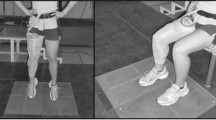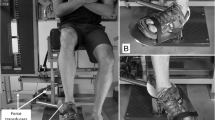Abstract
The acute effect of patella taping on torque and electromyographic (EMG) activity in maximal voluntary concentric and eccentric action of the knee extensor and flexor muscles in patients with patellofemoral pain syndrome was studied in 48 patients (62 knees). The patients (28 female, 20 male) were tested concentrically and eccentrically on a Kin-Com dynamometer with simultaneous EMG recording with the patella untaped and medially or laterally taped. Patients with clinically normal patellar mobility did not improve their quadriceps performance by taping of the patella: after medial taping they decreased theur muscle torque during concentric work at 60°/s (P<0.05) and eccentric work at 180°/s (P<0.05). After lateral taping they decreased their muscle torque during concentric work at 60°/s (P<0.01), and 180°/s (P<0.05) and eccentric work at both 60°/s (P< 0.01) and 180°/s (P< 0.05). Moreover, these patients also decreased their agonist EMG activity during concentric work at 60°/s (P<0.05) and 180°/s (P<0.05) and their antagonist EMG activity during eccentric work at 60°/s (P<0.01). Patients with a clinical lateral patellar hypermobility increased their knee extensor torque after medial taping at 60°/s during both eccentric work (P<0.01) and concentric work (P<0.05). The greatest improvement in quadriceps performance, however, was in patients with a clinical medial patellar hypermobility. They increased their knee extensor torque after lateral taping during eccentric work at both 60°/s (P<0.001) and 180°/s (P<0.001) and during concentric work at 60°/s (P<0.001). They also increased agonist EMG activity during eccentric work at both 60°/s (P<0.01) and 180°/s (P<0.001) and during concentric work at 180°/s (P<0.05). Patients with both lateral and medial patellar hypermobility increased their knee extensor torque by patellar taping in either direction; after medial taping there was an increase during eccentric work at both 60°/s (P<0.01) and 180°/s (P<0.05) and after lateral taping they also showed an increase during eccentric work at 60°/s (P<0.01). There was a slight decrease in knee flexor torque with either medial or lateral taping in comparison with no taping. Furthermore, there was higher antagonist EMG activity during hamstring measurements when the patella was either medially or laterally taped as opposed to untaped. In all four groups of patients, except for the group with lateral and medial hypermobility, there was a highly significant correlation between patients' own evaluation of the taping and their patellar mobility according to the clinical examination.
Similar content being viewed by others
References
Aglietti P, Pisaneschi A, Buzzi R, Gaudenzi A, Allegra M (1989) Arthroscopic lateral release for patellar pain or instability. J Arthroscop Rel Surg 5:176–183
Aglietti P, Buzzi R, Pisaneschi A (1990) Patella pain. J Sports Trauma Rel Res 12:131–150
Arvidsson I, Eriksson E, Knutsson E, Arnér S, (1986) Reduction of pain inhibition on voluntary muscle activation by epidural analgesia. Orthopedics 9:1415–1419
Bentley G, Dowd G (1984) Current concepts of etiology and treatment of chondromalacia patellae. Clin Orthop 189:209–228
Brunet ME, Stewart GW (1989) Patellofemoral rehabilitation. Clin Sports Med 8:319–329
Carson WG (1985) Diagnosis of extensor mechanism disorders. Clin Sports Med 4:231–246
Engebretsen L, Arendt E (1991) Patellofemorale smerter: diagnostikk og behandling (Patello-femoral pain: diagnosis and treatment). Tidsskr Nor Laegeforen 16:1949–1952
Ficat RP, Hungerford DS (1977) Disorders of the patellofemoral joint. Williams and Wilkins Baltimore
Fox TA (1975) Dysplasia of the quadriceps mechanism, hypoplasia of the vastus medialis as related to the hypermobile patella syndrome. Surg Clin North Am 55:199–226
Fulkerson JP, Shea KP (1990) Current concepts review disorders of patellofemoral alignment. J Bone Joint Surg [Am] 72:1424–1429
Gerrard B (1989) The patello-femoral pain syndrome: a clinical trial of the McConnell programme. Aust J Physiother 35:71–80
Goldberg B (1991) Chronic anterior knee pain in the adolescent. Pediatr Ann 20:186–193
Gransberg L, Knutsson E (1983) Determination of dynamic muscle strength in man with acceleration controlled isokinetic movements. Acta Physiol Scand 119:317–320
Henry JH, Crosland JW (1979) Conservative treatment of patellofemoral subluxation. Am J Sports Med 7:12–14
Hughston JC (1968) Subluxation of the patella. J Bone Joint Surg [Am] 50:1003–1026
Hughston JC, Deese M (1988) Medial subluxation of the patella as a complication of lateral retinacular release. Am J Sports Med 16:383–388
Insall J (1982) Current concepts review, patellar pain. J Bone Joint Surg [Am] 64:147–152
Knutsson E, Mårtensson A (1985) Isokinetic measurements of muscle strength in hysterical paresis. EEG Clin Neurophysiol 61:370–374
Kowall MG, Kolk GA, Nuber GW, Cassisi JE, Stern SH (1993) Patellar taping in the treatment of patellofemoral pain: a prospective randomized study. Presented at the AOSSM February 1993
Kramer PG (1986) Patella malalignment syndrome: rationale to reduce excessive lateral pressure. J Orthop Sports Phys Ther 8:301–309
Lysholm J, Nordin M, Ekstrand J, Gillquist J (1984) The effect of a patella brace on performance in knee extension strength test in patients with patellar pain. Am J Sports Med 12:110–112
McConnell J (1986) The management of chondromalacia patellae: a long term solution. Aust J Physiother 32:215–223
Minkoff J, Fein L (1989) The role of radiography in the evaluation and treatment of common anarthrotic disorders of the patellofemoral joint. Clin Sports Med 8:203–260
O'Neill DB, Micheli LJ, Warner JP (1992) Patellofemoral stress. A prospective analysis of exercise treatment in adolescents and adults. Am J Sports Med 20:151–156
Percy EC, Strother RT (1985) Patellalgia. Physician Sportsmed 13:43–59
Sega L, Galante M, Fortina A, Squazzini Viscontini G, Bertolotti G, Benedetti MG (1988) Association of dynamic bandage with kinesitherapy in the treatment of patellar instability. Ital J Sports Traum 10:89–94
Shellock FG, Mink JH, Deutsch A, Fox JM, Ferkel RD (1990) Evaluation of patients with persistent symptoms after lateral retinacular release by kinematic magnetic resonance imaging of the patellofemoral joint. J Arthroscop Relat Surg 6:226–234
Steadman JR (1979) Nonoperative measures for patellofemoral problems. Am J Sports Med 7:374–375
Teigte RA (1990) Stress X-rays of the patellofemoral joint. Presented at the 4th European Society of Sports Traumatology, Knee Surgery and Arthroscopy conference, Stockholm, 1990
Van Kampen A, Huiskes R, Blankenvoort L, van Rens Th JG (1986) The three dimensional tracking pattern of the patella in the human knee joint. Orthop Trans 10:418
Voight M, Wieder D (1991) Comparative reflex response times of vastus medialis obliquus and vastus lateralis in normal subjects with extensor mechanism dysfunction. An electromyographic study. Am J Sports Med 19:131–137
Westing SH, Cresswell AG, Thorstensson A (1990) Muscle activation during maximal voluntary eccentric and concentric knee extension. Eur J Appl Physiol 62:104–108
Whitelaw GP, Rullo DJ, Markowitz HD, Marandola MS, DeWaele MJ (1989) A conservative approach to anterior knee pain. Clin Orthop 246:234–237
Yates C, Grana WA (1986) Patellofemoral pain-a prospective study. Orthopedics 9:663–667
Yoshioka Y, Siu D, Cooke TDV (1987) The anatomy and functional axes of the femur. J Bone Joint Surg [Am] 69:873–880
Author information
Authors and Affiliations
Additional information
This study was supported by grants from the Swedish Sports Federation and from Beiersdorf Compancy, Homburg, Germany
Rights and permissions
About this article
Cite this article
Werner, S., Knutsson, E. & Eriksson, E. Effect of taping the patella on concentric and eccentric torque and EMG of knee extensor and flexor muscles in patients with patellofemoral pain syndrome. Knee Surg, Sports traumatol, Arthroscopy 1, 169–177 (1993). https://doi.org/10.1007/BF01560200
Issue Date:
DOI: https://doi.org/10.1007/BF01560200




